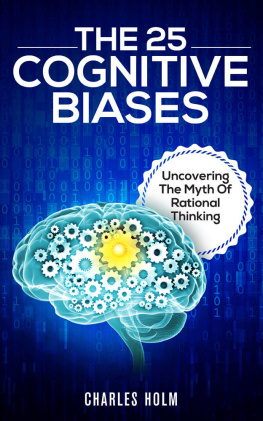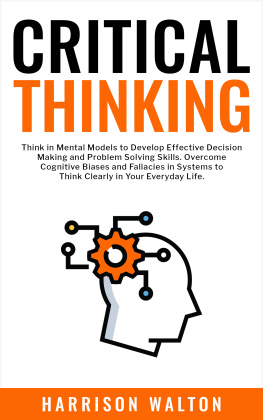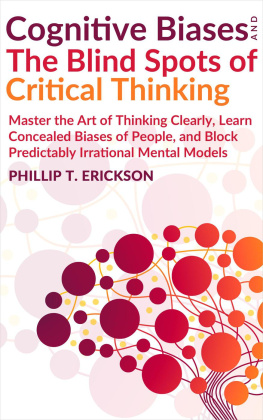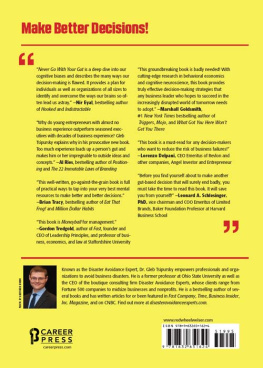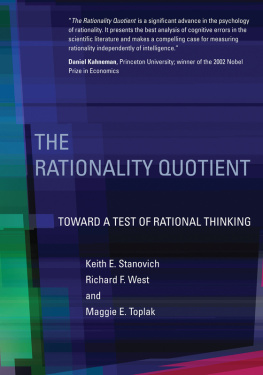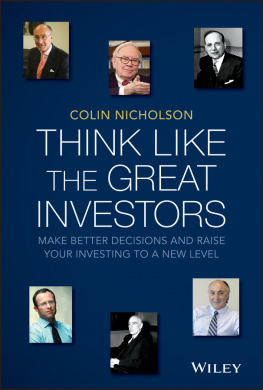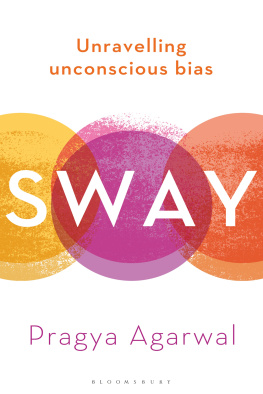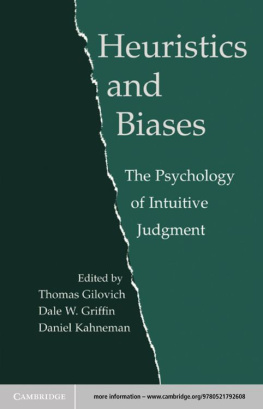The25 Cognitive Biases
UncoveringThe Myth of Rational Thinking
ByCharles Holm
Copyright 2015 by Charles Holm
All rights reserved in allmedia. No part of this book may be used or reproduced without writtenpermission, except in the case of brief quotations embodied incritical articles and reviews.
Tableof Contents
Preface
Wehumans applaud our ability to be rational, objective thinkers. Inreality this is not the case at all. We all have the tendency tooverestimate our rationality to the point of denying reality. Themany ways in which we do this are collectively called cognitivebiases. Our brain may be the most complicated thinking machine but itis not without limitations. In our attempt to understand the worldaround us through our lens we simplify things and fall prey tocognitive biases. Sometimes these biases are caused by heuristics ormental shortcuts which help us reach quick judgments when we havelittle time. At other times our judgment is clouded by situationalfactors and inner motivations and emotions.
Howeverwe are not completely helpless in this aspect. Knowing these biasesexist can help us avoid them through conscious efforts. We need to beable to recognize these biases in our decision making. They areinevitable in most cases but they are not impossible to bypass.
Chapter 1: Projection Bias
Youare all invited to a fun get together at my house where we will watchpopular Japanese anime, eat caramel popcorn, paint each othersfaces and play hide and seek in the yard
Thehost of this party has mistakenly assumed everyone else shares theirdefinition of fun. This tendency to confidently assumethat others share our thinking pattern, attitudes and beliefs isknown as the projection bias. A related effect known as thefalse-consensus bias takes this tendency a step further making usbelieve others agree with our views as well . We holdon to these assumptions despite knowing it is impossible for everyoneto use the same mental framework that we do.
However,the projective bias is not limited to the views of other people butalso includes incorrect predictions about our own views at any pointin the future. Our decisions for the future are majorly based on theassumption that our current preferences will stay the same regardlessof time. Aman who is very hungry will end up buying more food than what hewould normally eat assuming his future self will be just as hungryas he is in that moment.
Themain problem underlying projection bias is not being able tounderstand that you are different from others. Hence a way ofavoiding this is to give some time, before making quick judgments, tothink about how others perception can be different from yours. Asimple way to find this out can be to ask their opinions beforehand.
Chapter 2: HyperbolicDiscounting
Wouldyou prefer to get $5 right now or $10 in two weeks? If your immediate answer is $5 you just engaged in yet another biasknown as hyperbolic discounting. This refers to our tendency tochoose a smaller reward given sooner over a delayed larger reward. Wetend to place a higher value on temporal proximity (nearness of theevent to the present) rather than the actual reward becausewe want to avoid waiting. You might have also considered thealternate to be a rational choice. But then again, cognitive biasesgo against all common sense.
Whyis it called hyperbolic? The tendency to fall prey tothis bias decreases as time for both rewards gets further away fromthe present. So you may prefer to get $100 in 5 years than 50$ in 4years. You may think if you have to wait that much anyway why notwait another year and get double the amount. The reason this thinkingis considered irrational is because we are viewing the same problemdifferently simply based on the temporal proximity. People in themarketing business are well aware of this bias and increase theirsales by offering a smaller reward sooner in place of a bigger rewardlater.
Chapter 3: FundamentalAttribution Error or Correspondence Bias
Aman bumps in to you and walks away without an apology. What are theimmediate thoughts running in your head at that moment about thatstranger? You are most definitely summing up a list of all the bad qualitieshe must obviously posses. The truth may very well bethe complete opposite. Maybe he is just too distracted by somethingimportant and never intended to be rude. This is what we call thefundamental attribution error. In face of such events we immediatelyjump to the conclusion that a persons behavior in thatparticular moment is not an isolated event but represents his or herpermanent traits. We automatically tend to disregardthe possibility of environmental and social influences while makingquick judgments. This primarily happens because our entire focus ison the person. In order to understand what happened, we pick up andinterpret that persons behavioral cues as a reflection of hispersonality and completely ignore any obvious situational cues.
Away to avoid falling prey to this bias is to put yourself in thatpersons shoes and think of all the possible events that couldmake you act the same way. This will help you realize that we dontalways act ourselves in certain situations.
Chapter 4: Curse of Knowledge
Iam having trouble breathing, Sam complained to his doctor
Theposterior wall of your nasopharynx is inflamed, with hyperemia andacute follicular tonsillitis, the doctor assured him after athorough examination
Iam going to die? Sam asked white as a sheet.
No..NoImeant you have a sore throat!
Knowledgeis power they say but it can become a curse as well. Too muchknowledge about anything hinders our ability to understand thingsfrom the perspective of other less informed people. When faced with asituation where we are questioned about an area of our expertise wealways tend to use jargons and technical terms without realizing thehigh possibility that the otherperson may not be aware of them. What we once had to learn ourselvesbecomes common knowledge leading to incorrect assumptions about howmuch other people understand.
Thiscan be avoided through conscious practice. No matter how much of anexpert you are in any area always remind yourself how you were onceless informed too. Start off with the basic stuff first to get anidea of what level of understanding your audience stands at. Once youhave done that, only then move on to technicalities.
Chapter 5: Dunning-Kruger Effect
Amyconfidently walks in to audition for a local singing competition.
Youseem confident. Do you think you have what it takes to win thiscompetition?
Iam 110% confident you will love my singing. Amy replied with abroad smile.
Shebegan singing in her high-pitched voice as the judges stared at her,horrified.
Haveyou ever come across people that you know are less competent yet theyconfidently claim to be otherwise? This is in fact another cognitivebias called the Dunning-Kruger effect. We tend to deny our failuresmore than we realize. We fail to acknowledge the gap that existsbetween our actual performance and how we perceived our performance.People who are susceptible to this bias lack the capacity to analyzetheir own performance. Hence, they end up believing they are muchmore competent than they actually are. In order to make sure we dontbecome a victim of this bias we must always accept feedback fromothers and learn from our mistakes.
Onthe flip side, highly competent people may appear to be humble andrate their competence lower than it actually is. This is known as theimposter syndrome. Overachievers tend to believe thattasks that are easy for them have to be easy for others as well. Thisis why they end up downplaying their competence as compared toothers.
Chapter 6: Framing Effect
Next page
